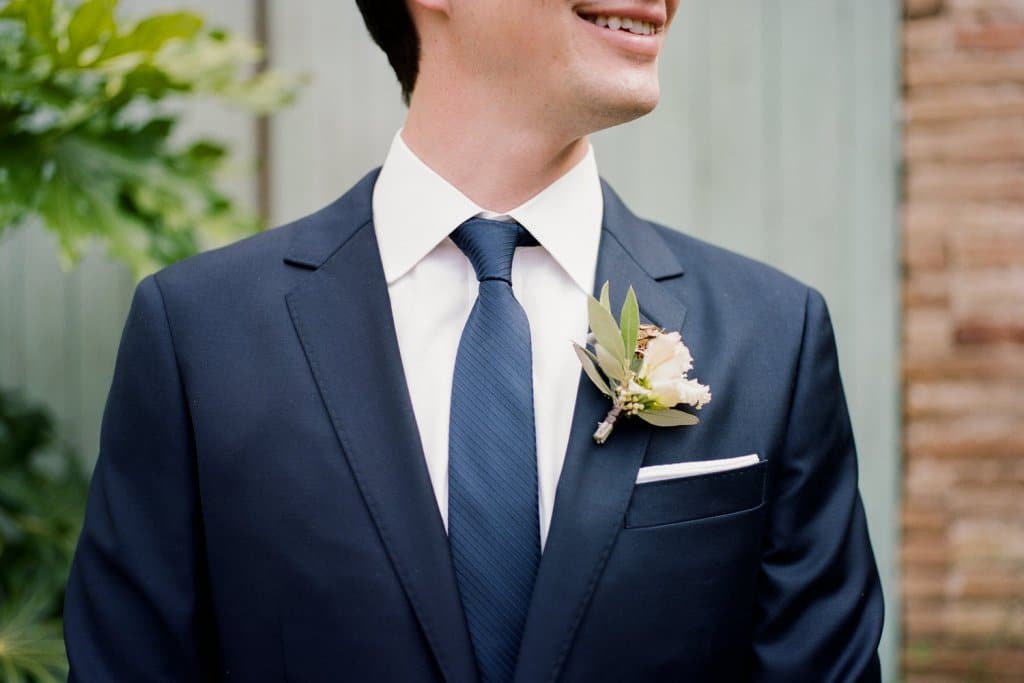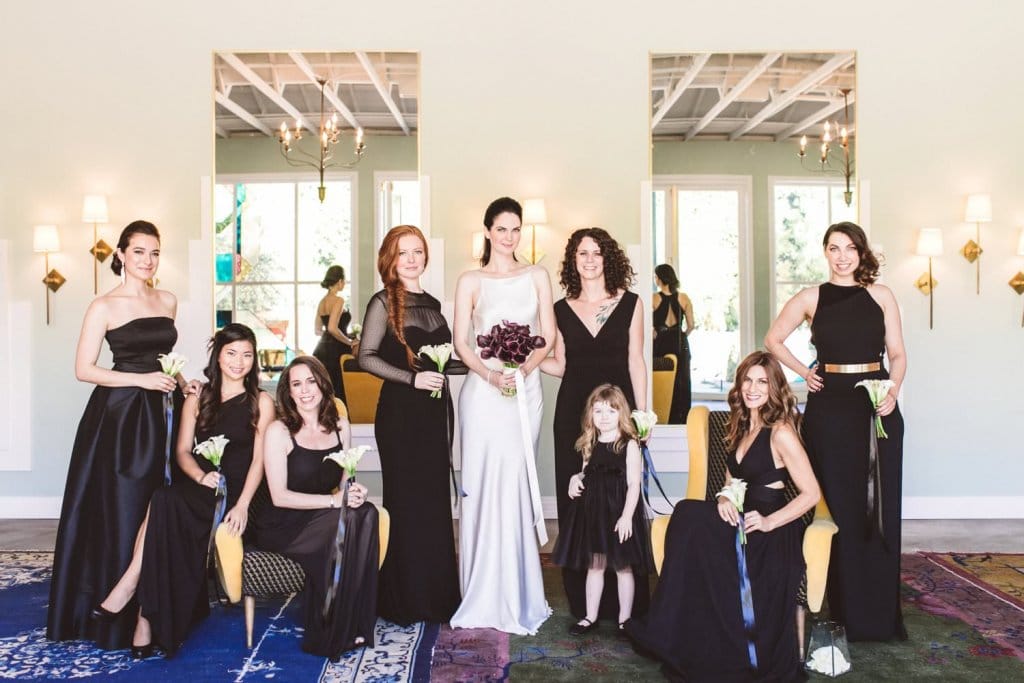I joke with a lot of clients that planning a wedding equips you with an array of new vocabulary words. Many of these words you’ve never heard of, and most of them won’t apply to any other area of your life. They exist in your consciousness for wedding planning alone.
In an attempt to help you with the learning curve (and maybe get some giggles out of you, too), here is our wedding dictionary “cheat sheet” for understanding some unfamiliar words or phrases; they may have limited applicability, but are still an integral part of your introduction to the world of wedding planning.

An example of a boutonniere, worn by Tyler on the day of his wedding to Ashley in Olivella, Spain
Boutonniére
A single flower OR a small bunch of flowers, greenery, or other natural elements bound together with ribbon or twine for the groom, groomsmen, and the groom’s male family members, ushers, officiant, and/or other male attendants. It is pinned to the left-side jacket lapel. In the absence of a jacket, it can also be pinned to suspenders or a vest (also on the left side in the same general location).
Bustle
The ability to attach the train of a wedding dress to the upper part of the skirt (toward the waist), usually done after the ceremony. While a train is elegant and beautiful for the ceremony and for portraits, it’s much less practical for greeting your guests and dancing the night away. Dragging around a heavy train increases the odds of tripping over yourself, or of guests tearing the bottom hem by stepping on the train accidentally. The bustle was first introduced in the later 1860s and its purpose was to maintain the shape of a full skirt made from heavy fabrics (the larger the skirt, the smaller the appearance of a lady’s waist). Wedding dress bustles typically involve snap closures, buttons, hooks, or even ribbon ties to keep your dress from dragging on the floor after you say “I do.”
Charger
Nope, not a Los Angeles football player. A charger is a fancy dish placed beneath the dinner plates, typically used during more formal, full-course meals and not meant for use with food. In modern weddings, chargers are also showing up at weddings with more a casual dining atmosphere and take different forms (like the black marble chargers Vanessa used from Borrowed Blu for our shoot at the Hollywood Roosevelt Hotel, below).

Vanessa used black marble chargers at these place settings for something edgier and more modern than a traditional charger.
Chuppah
A canopy above a Jewish couple during their wedding ceremony. A traditional “chuppah” or “huppah” usually has a cloth or tallit draped over four poles, and the couple stands underneath the cloth during the ceremony; the chuppah symbolizes the home they will build together in marriage. The term “chuppah” is sometimes used more casually to describe the arch or structure that a non-Jewish couple might use to stand beneath or in front of during their wedding ceremony.
Escort card
This is just a fancy name for “place cards.” Escort cards bear the names of your beloved guests and direct them to their appointed seats.
First look
Also referred to as “first glance,” this isn’t my favorite term for this special moment between a couple on their wedding day, but it is appropriately descriptive, so it works. A “first look” is when the bride(s) and groom(s) opt to see each other before the ceremony, usually in a private moment between the two of them (and their photographer[s] and/or videographer[s], as well). This is a great photo opportunity used to (a) capture a more intimate “first moment together on the wedding day,” and (b) as an option for getting some photos done before the ceremony, which helps ease the rush of post-ceremony portraits and sometimes enables the bride and groom to attend cocktail hour instead of spending the entire time with their photographer. The “first look” is also a chance for couples to rid themselves of nervousness or anxiety they may be experiencing in anticipation of the ceremony itself. Read more on our thoughts about a “first look” here.

We’re pretty big fans of the “first look” as a chance to get plenty of pre-ceremony portraits.
Officiant
The person who presides over the wedding ceremony. The officiant must be ordained in the state where the wedding takes place in order for the union to be legally recognized.
Processional
This begins the ceremony when the bridal party (also the officiant, parents, grandparents, etc.) enters the ceremony area, usually walking down the aisle.
Recessional
This closes the ceremony; the same people who walked down the aisle for the processional leave the ceremony by walking back up the aisle (following the bride and groom after their first kiss as husband and wife).
Save the Date
A greeting card or postcard sent to wedding guests in advance of the formal wedding invitation. The tradition of “save the dates” was initiated to alert out-of-town guests of the date of the wedding so they could make appropriate travel arrangements. These days, many couples send “save the date” cards even if their guests are mostly local, and sometimes use photos from their engagement session to adorn the card or postcard.
Sweetheart table
A dining table reserved for just the happy couple. A sweetheart table is an alternative to the more traditional “head table,” which typically seated the bride, groom, wedding party, and sometimes parents and immediate family members.

Valerie & Joey’s sweetheart table at their Walnut Grove wedding in May.
Toss bouquet
Your florist may create an additional, smaller bouquet for you to use for the bouquet toss toward the end of the reception. This is an especially good idea if your bouquet is on the large side, or you want to keep it for preservation.
Toss garter
If the bride’s garter has sentimental value (for example, a family heirlooms or an expensive purchase she may wish to keep), she might also wear a “toss garter,” which is a smaller, less expensive (usually elastic lace) garter that the groom can remove and toss toward the end of the reception.
Usher
Usually selected from male friends or family members, though modern weddings have female ushers, too. Wedding ushers greet guests upon their arrival at the wedding ceremony site, showing them to their seats (whether assigned or open) and handing out programs. It’s also helpful for the usher to know where the restrooms are located, where to find refreshments, and which side is traditionally reserved for the bride (left for a Christian ceremony, right for a Jewish ceremony) and which is reserved for the groom (right for a Christian ceremony, left for a Jewish ceremony). Most wedding planners will recommend a minimum of one usher for every 50 wedding guests.
Wedding party
All attendants of the bride and groom, including the maid/matron of honor, best man, bridesmaids, groomsmen, flower girls, and ring bearer. This is also sometimes referred to as the “bridal party,” but the dudes are still included (not just the ladies, despite the term “bridal”).

The bridesmaids and flower girl at Stephanie and Eli’s Fig House wedding make up just part of the wedding party; also included are groomsmen and ring bearers.
More resources for understanding all the wedding terms you’ll be hearing!
